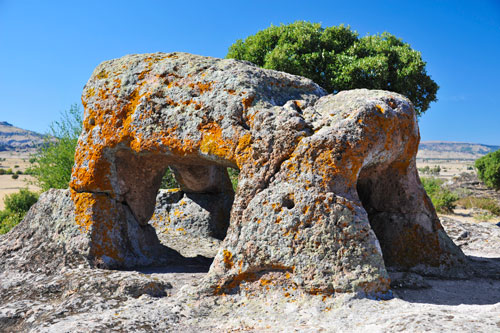Nuraghe Santu Antine and Necropolis Sant’Andria Priu
map of the surroundings with marked sights
Valle dei Nuraghi
 Actually, the area has long been called “Campu di Cabu Abbas” (Origin of the Waters).
Actually, the area has long been called “Campu di Cabu Abbas” (Origin of the Waters).
Since the remains of 32 Nuraghi are located here, the name “Valle dei Nuraghi” (Valley of the Nuraghi) emerged with tourism.
The photo shows the Nuraghe Oes.
Most Nuraghi are hardly or only with difficulty accessible. The only one made accessible to tourists is Santu Antine.
Nuraghe Santu Antine
 The impressive fortification is one of the largest in Sardinia and can certainly be compared with the complexes of Su Nuraxi and Palmavera.
The impressive fortification is one of the largest in Sardinia and can certainly be compared with the complexes of Su Nuraxi and Palmavera.
Construction began around 1000 BC, with the main tower being built first. In the following centuries, the defensive wall with the three corner towers was added.
Around the Nuraghe were the round huts of a village, whose foundations have been partially excavated again.
The total height of the tower was originally about 25 meters, today 17.50 meters. This makes Santu Antine the tallest of all the still preserved Nuraghi on the island.
 The complex can be visited individually and is particularly impressive inside with its enormous dimensions.
The complex can be visited individually and is particularly impressive inside with its enormous dimensions.
Roughly hewn basalt blocks from the nearby area were used as building material.
The best impression of the builders’ achievement is gained by looking down into the courtyard from the defensive wall.
It is admirable how precisely and at what height the heavy stone blocks were stacked. After all, the tower is over 3000 years old and still stands today.
A deep well is preserved in the courtyard, which secured the vital water supply during sieges.
 From the courtyard, two passages lead to the outer defensive tower opposite.
From the courtyard, two passages lead to the outer defensive tower opposite.
These passages are artificially lit – the only openings to the outside are narrow loopholes.
Another set of passages was located on the floor above. Today, they are open to the top because the wall has been partially removed over time.
Sant’ Andria Priu

The necropolis of rock tombs (“Domus de Janas”) is about 12 km from the Nuraghe Santu Antine.
The site is considered one of the most beautiful in Sardinia and was created during the Ozieri culture around 3500 – 2700 BC.
The complex consists of 20 grottoes carved into the trachyte rock.
The larger tombs were used as churches in the Middle Ages and accordingly equipped with stairs, larger entrances, and window openings.
 Above the necropolis towers a strange figure named “Il Toro”.
Above the necropolis towers a strange figure named “Il Toro”.
This figure, carved from a single block of trachyte, presumably represented a bull.
It is believed that during early Christianity, the head of this pagan idol was removed.

The “Tomba a Camera” (photo) was modeled after a hut. The ceiling looks like a gabled roof supported by two pillars.
The highlight of the entire necropolis is the “Tomba del Capo” – the “Chief’s Tomb.” With its 18 chambers, it is the largest tomb in the complex.
From the time when it was used as a cave church, remnants of beautiful Byzantine wall paintings are still preserved.
This tomb is the only one locked by guards. It can only be visited as part of a small guided tour, and photography is strictly forbidden here.
